|
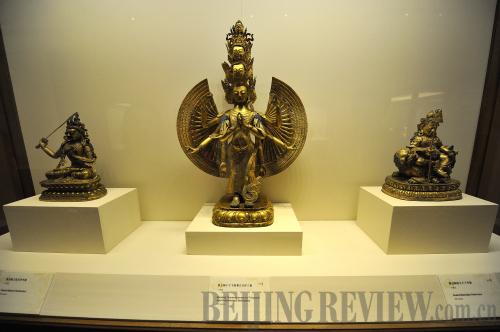 |
|
A standing gold-coated statue of Guanyin of the 18th century (SHI GANG) |
After four years of renovation work and an expansion to its floor space, the National Museum of China (NMC) reopened on March 1 this year. The museum has nearly tripled in size from about 65,000 square meters to 191,900 square meters. As far as size, the new NMC is the largest museum in the world, said the official website of the NMC.
New look
Besides expansion of size, the facilities of the new NMC have been greatly upgraded. The museum's interior is a combination of traditional and modern flavor. From west to east, there are three main halls inside the museum. The gate of the west hall has seven bronze gates engraved with decorative patterns of ancient bronze ware. The hall is an important entry and exit way, and from here visitors will enter an art gallery area along a 330-meter north-to-south axis and a 200-meter east-west corridor connecting all three halls.
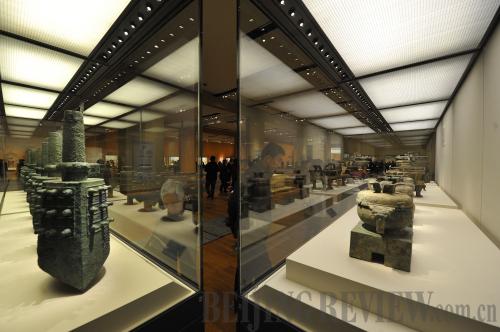 |
|
BRONZE WARE: (Left) A set of percussion instrument made during the Spring and Autumn Period (770-476 B.C.) of China. They were unearthed in Anhui Province in 1955 (Right) Food containers of the Spring and Autumn Period unearthed in Anhui Province in 1955 (SHI GANG) |
The 2,000-square-meter central hall is used for opening ceremonies of important exhibits and events held at the museum. Four lounge halls are found on both sides of the hall.
The museum now has a total exhibition area of 65,000 square meters with 49 exhibition halls ranging in size from 800 square meters to 2,000 square meters. It also includes an Asia room, Africa room, Europe room and America room for exhibiting art and cultural relics from these regions.
The NMC's storeroom is over 30,000 square meters and can accommodate more than 1.2 million cultural relics. The temperature and the humidity there are controlled to protect the collections. Measures on lightning protection, anti-pollution, waterproofing, quakeproofing and fireproofing are state of the art.
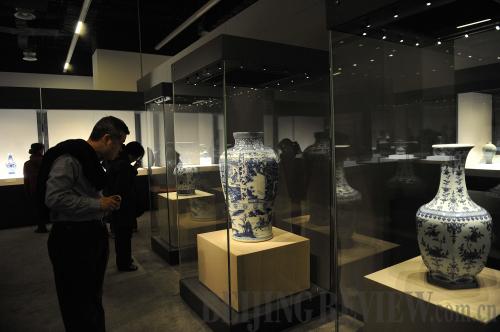 |
|
BLUE AND WHITE BEAUTY: Visitors appreciate ancient porcelain exhibits on April 1 (SHI GANG) |
The second floor of the new museum provides interactive experience for visitors of different ages and with different interest. Computer programs dive into movies, opera, music, art, science and technology, allowing visitors to fully understand and appreciate each exhibit.
The new museum also has a theater with 800 seats, a 600-square-meter multimedia room and a conference hall with 300 seats. The multimedia room will allow visitors to get an up-close look at national treasures on display, said the Information Office of the NMC.
One of the museum's more innovative features is its 20,000-square-meter rooftop green belt, the largest in Beijing. The green belt not only contributes to providing cleaner air to the city but also helps prolong the service life of the building material on the roof, an engineer of the NMC said. Green technology was also employed when renovating the NMC, including external windows that filter out ultraviolet light and skylights in the central hall that could act as natural ventilators.
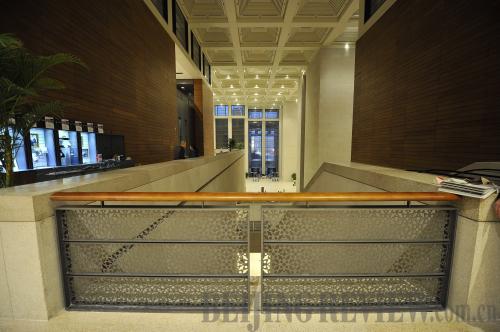 |
|
The third floor of the newly refurbished National Museum of China (SHI GANG) |
If visitors are tired and want to taste tea or coffee, there's a tea room and a coffee house; if they need souvenirs for friends, there are many unique gifts to buy in the museum gift shop; and there are also bookstores inside the NMC to meet visitors' reading demands.
Currently, the NMC houses as many as 1.06 million artifacts. Before the renovation work, there were 650,000 pieces in the museum's collection. Last February, the Ministry of Culture and the State Administration of Cultural Heritage transferred about 400,000 cultural relics to the NMC, said Lu Zhangshen, Curator of the NMC.
"This was an unprecedented event. These relics—including jade, porcelain and Buddha statues—are all priceless. This shows the importance the Central Government has placed on preserving and displaying cultural heritage," Lu said.
There are special exhibition halls for ancient arts, such as bronze art, figures of Buddha, porcelain, paintings and calligraphy, furniture and coins, he said.
"The museum displays the history and civilization of the Chinese people, from the earliest trace of human existence through different dynasties right up to the present," said Dong Qi, Deputy Curator of the NMC.
Permanent exhibitions in the museum will be free to the public, while some special exhibitions will charge a relatively small fee due to extra expenses.
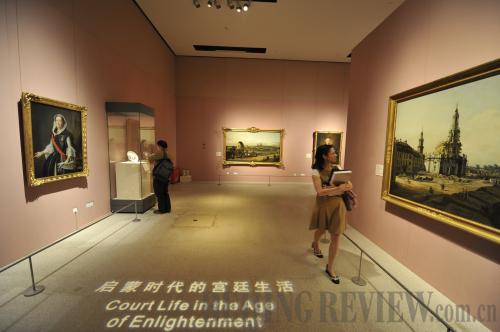 |
|
FOREIGN ART: Visitors appreciate the paintings displayed at the Art of the Enlightenment exhibition on April 1 (SHI GANG) |
"In consideration of security and the museum's atmosphere, we will charge a little to limit visitors. If we don't limit the volume of visitors, the museum will be overcrowded and no one will be able to really enjoy the exhibits. Too many people will also make guarding the treasures more challenging," said Lu.
The museum restricts the number of visitors to a daily maximum of 8,000. Visitors can get their free tickets for the exhibitions at the north and west gates of the museum. It opens every morning at 9 a.m. and closes at 5 p.m. except Monday.
It is estimated that the new museum could receive 8 million to 10 million visitors a year. It is not only a public place but also an important venue providing cultural enjoyment, said Lu.
| 